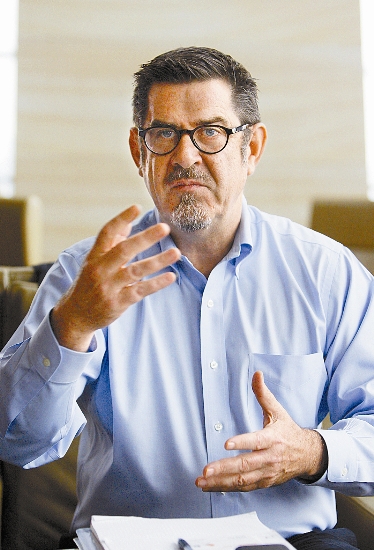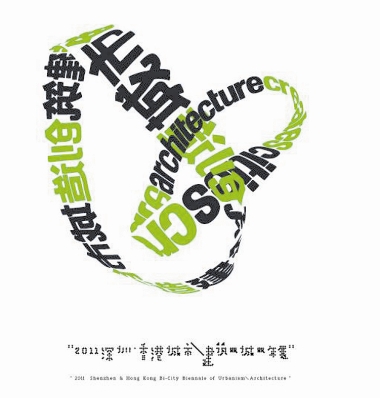|


Newman Huo
TERENCE RILEY, chief curator of the 2011 Shenzhen-Hong Kong Bi-City Biennale of Urbanism and Architecture, presented the curatorial proposal for the 2011 edition of the biennale at a press conference in Shenzhen on Tuesday, saying he was determined to make the biennale an international event, “similar to any other international event, such as the Venice Biennale of Architecture and Sao Paulo Art Biennial.”
Riley was selected after an international call for proposals last year, and has been appointed by the biennale’s organizing committee as the event’s first non-Chinese chief curator since its launch in 2005.
An internationally acclaimed curator and architect, Riley is the former director of the Miami Art Museum and the Philip Johnson Chief Curator of Architecture and Design at the Museum of Modern Art, New York where he played a key role in overseeing MoMA’s 2004 expansion project.
Riley’s assertion says that “Architecture creates cities, and cities create architecture” will be the theme for the 2011 bi-city biennale. The biennale will portray the interaction between architecture and cities, and provoke an in-depth discussion on sustainability and urban vitality. It will look into China’s and Shenzhen’s examples in comparison with the “global experience.”
“The theme represents a relationship between cities and architecture that can be seen as global, especially in terms of contemporary culture,” Riley said.
“However, the Shenzhen biennale will look at cities and architecture in the context of time as well as place,” he said.
The biennale’s logo, designed by the renowned Chinese graphic designer Wang Xu, graphically interprets the theme by stringing two sentences together in the form of a Mobius strip.
“The curatorial proposal for the 2011 biennale is consistent with the previous three editions, but more international, contemporary and profound,” said Feng Yueqiang, an architect from the Biennale Academic Committee.
“This year’s biennale will continue to lead discussions on the essence of ‘Urbanism and Architecture’ and to enquire about the motif,” Feng said.
Riley’s curatorial proposal outlines 17 exhibitions, which will be featured during the 2011 bi-city biennale from Dec. 11 this year to Feb. 10 next year.
Riley has nominated a number of scholars, architects and artists as members of the curatorial team, including Rochelle Steiner, dean and professor of Roski School of Fine Arts, University of Southern California, Jeffery Johnson, director of China Lab, Columbia University, Tang Keyang, curator of China Pavilion at the 12th Venice Architectural Biennale, Jonathan Solomon, acting head of the department of architecture of Hong Kong University, and Mary Ann O’Donnell, research associate at the College of Arts, Shenzhen University.
The featured exhibitions in Riley’s proposal include the aim of a “global experience.” The exhibition “Cities<60” is a research project, which retrospectively investigates the successes and failures of six new cities, including Shenzhen, Las Vegas in the United States, Almere in the Netherlands, Gaborone in Botswana, Brasilia in Brazil, and Chandigarh in India. The exhibition will also feature new videography tracing their ongoing evolution from master plans to actual cities.
Additional exhibitions, such as “8 Urban Plans for China,” “8 Regional Plans for China,” “Urban China Timeline,” and “Shenzhen Timeline,” will provide in-depth studies on urbanization at the regional and city level in China.
The exhibition “Shenzhen Builds” will exhibit five major urban projects designed by leading architects from China and abroad currently or soon to be under construction in Shenzhen. It will reveal their design processes and the projects’ impact on the surrounding environment, architecture and urban development.
The exhibition “Counterpart Cities” will select six groups from Shenzhen and Hong Kong respectively, to investigate their common ecological and environmental issues and propose solutions.
In addition, the exhibition “Mi Qiu — A World of Layers” will discuss the idea of a core concept of a public architectural plan and the practical spatial demand of human beings.
There will be an “Exhibition of Universiade Stories” which showcases the newly constructed stadiums, and investigates the impact that the large public event has on Shenzhen.
In addition, the Hong Kong organizing committee was successful in securing sponsorship from the Hong Kong government and will work together with Shenzhen to truly make this a bi-city biennale.
Based on Riley’s curatorial concepts, the Hong Kong edition will work to complement the Shenzhen edition in an integrative way.
The biennale in Hong Kong is now under preparation and expected to open in early January 2012.
The biennale will set a stage for young architects, artists and designers to participate. The exhibition “Street” will invite an international roster of 12 architects in their 30s and 40s to design 12 facades in their own architectural language, as well as an installation of their work.
The exhibition “In My Perfect World…” will encourage architects to self-nominate visionary projects that fundamentally challenge our preconceptions about cities and about architecture. An online submission process will offer an opportunity for young architects, artists and designers to showcase their work at the biennale.
In the 2009 biennale, the Civic Square in front of the Civic Center was reconnected with urban life and activities through experimental interventions.
This year’s biennale will further explore the potential of this area. New York architects, John Bennett and Gustavo Bonevardi, will reactivate the space through a series of installations.
Another project “Ultralight Village” will consist of six structures to be designed by leading contemporary architects from around the world and erected along the axis that passes through the Civic Center and connects the Central Walk plaza and Lianhua Hill to the north.
The 2011 biennale will also exhibit an award-wining project from the Venice Biennale of Architecture.
In an effort to internationalize the biennale, many countries, including Austria, Chile, Egypt, Finland, Switzerland and the Netherlands, were invited to participate.
Antonius Lambertus Maria Van Zeeland, consul general of the Netherlands Consulate in Guangzhou, has proposed the idea of “International Pavilions” for this year’s biennale.
|

